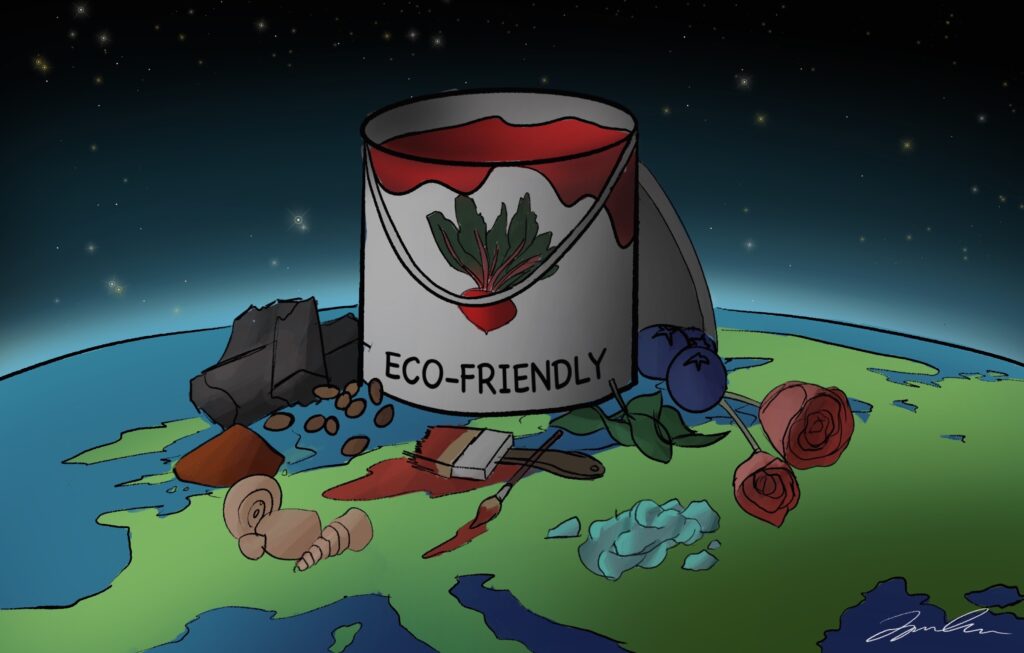
Even though many artists attempt to highlight the natural world through art, many are destroying nature in the process. Mass-produced art supplies use many materials that are harmful to the environment. Many artists are destroying the very environment they attempt to recreate.
However, there are many eco-friendly alternatives to normal art supplies. These practices of using natural art supplies stem back to multiple cultures. Most prominently seen in South Asian and Native American art, natural paints and brushes were used to create beautiful artwork (Houghtelling, 2016). In India, many artists utilized natural pigment resources such as tamarind, turmeric, and indigo to stain fabric. Many artists used these natural resources with little effect on the world around them. This sustainable form of art has lasted many years and is seen throughout many art pieces that hang in museums today (Houghtelling, 2016). Additionally, many Native Americans used products found in their surroundings in their art. In replacement for red paint, Native Americans used the red and black of the tree bark. They also used lichens and the Oregon grape for a yellow tint (Marianopolis College, 2004). South Asian and Native American cultures are a few of many societies that implemented similar techniques to create art.
On the other hand, modern-day art supplies are produced in such a way that they emit harmful toxins when created or even when improperly disposed of. For example, an average one gallon of paint takes about thirteen gallons of water to make, only increasing the carbon footprint of paint factories (McClough, 2021). Furthermore, synthetic paint brushes are made out of plastic that would take over 450 years to fully decompose, only adding to the immense amount of leftover plastic in the environment (McClough, 2021).
Recently, many artists have shared more eco-friendly ways to still enjoy the same art supplies but in a more sustainable way. Many companies have devoted themselves to making eco-friendly products by reusing their water and recyclable production materials (McClough, 2021). Many acrylic paint companies prioritize the output rate rather than the actual harm of the products, but companies such as Natural Earth Paint and Golden Artist Colors recycle their plastic and reuse their water and electricity. Also, paintbrushes have many eco-friendly options such as corn, bamboo, and hala (McClough, 2021).
Even though many commercial art companies are hurting the environment in an effort to create a large number of products, it is possible to take a step back from these supplies. Rather than ironically painting nature with harmful substances, with a few small changes, it is possible to portray art’s beauty while helping the environment.
Works Cited:
Dyes and pigments of Indians. (n.d.). http://faculty.marianopolis.edu/c.belanger/quebechistory/encyclopedia/DyesandpigmentsofIndians.htm
McClough, L. (2022, January 6). Sustainability of Art Supplies – Environmental Justice Coalition – Medium. Medium. https://medium.com/environmental-justice-coalition/sustainability-art-supplies-76d5d9d8089e#:~:text=Synthetic%20paint%20%20brushes%20%20take%20%20over,made%20from%20%20nonrenewable%20%20natural%20gas.
Painting with Dyes in Early Modern South Asia. (2016, May 17). The Metropolitan Museum of Art. https://www.metmuseum.org/blogs/ruminations/2016/painting-with-dyes-early-modern-south-asia Painting with Natural Pigments. (n.d.). Grand Rapids Art Museum | 101 Monroe Center NW.
The views and opinions expressed are those of the authors and do not necessarily reflect nor represent the Earth Chronicles and its editorial board.




